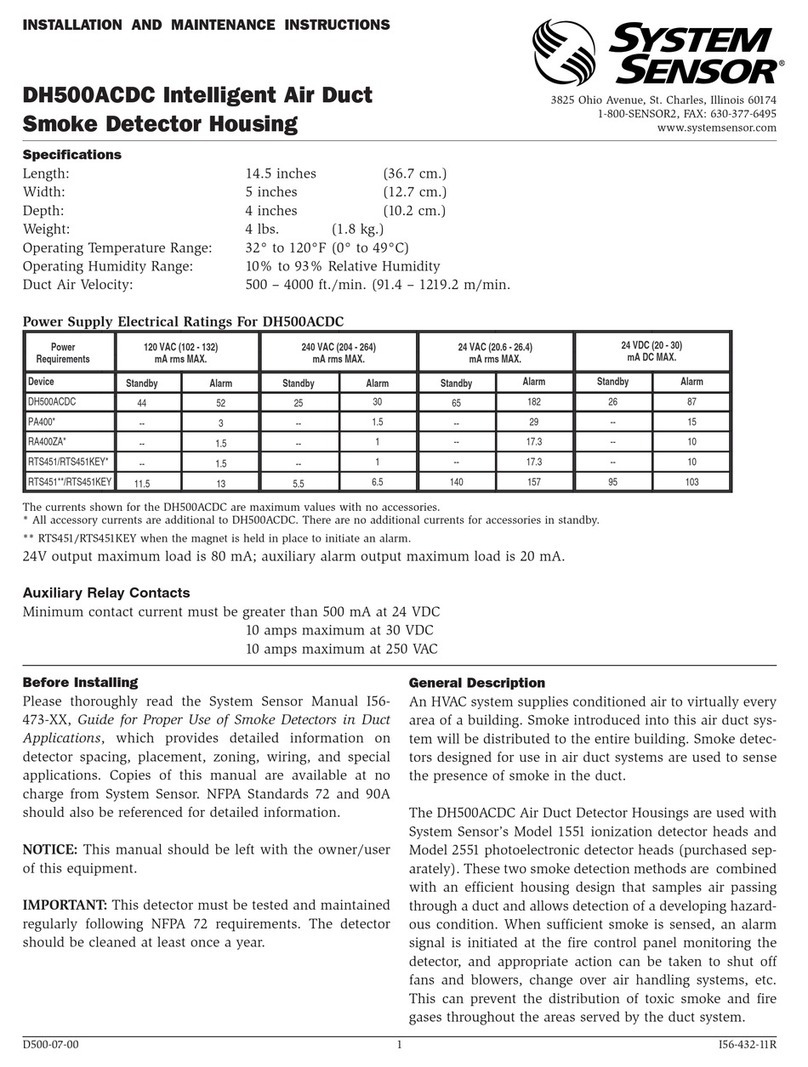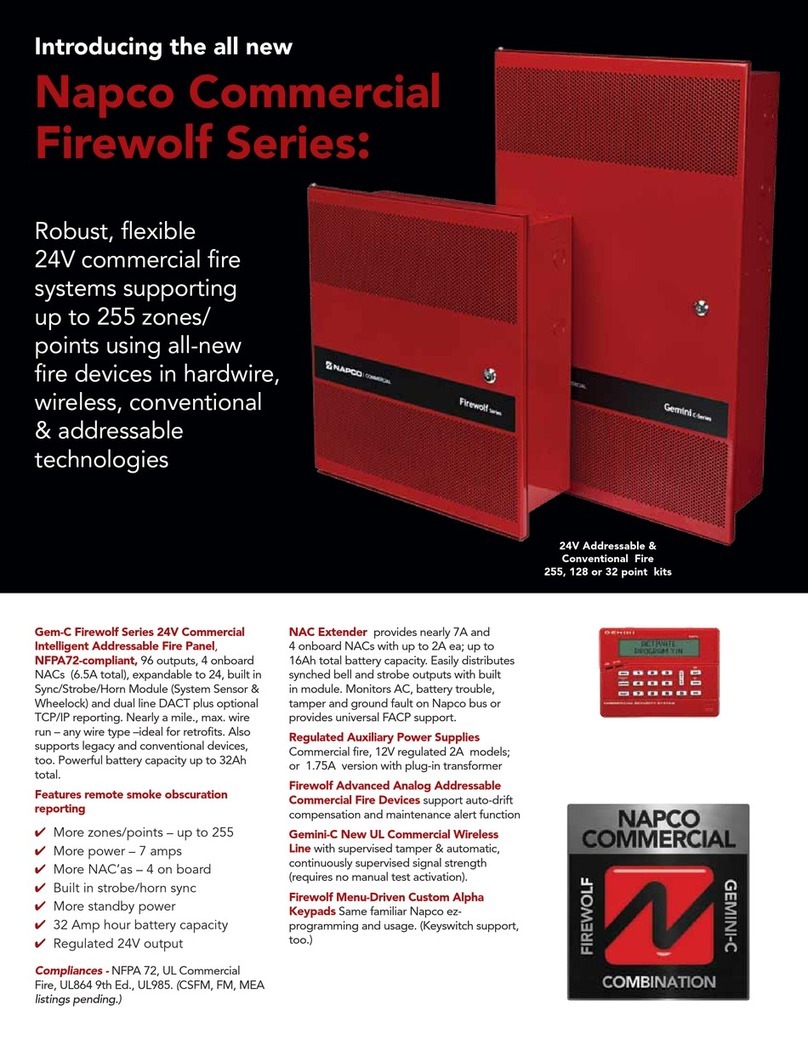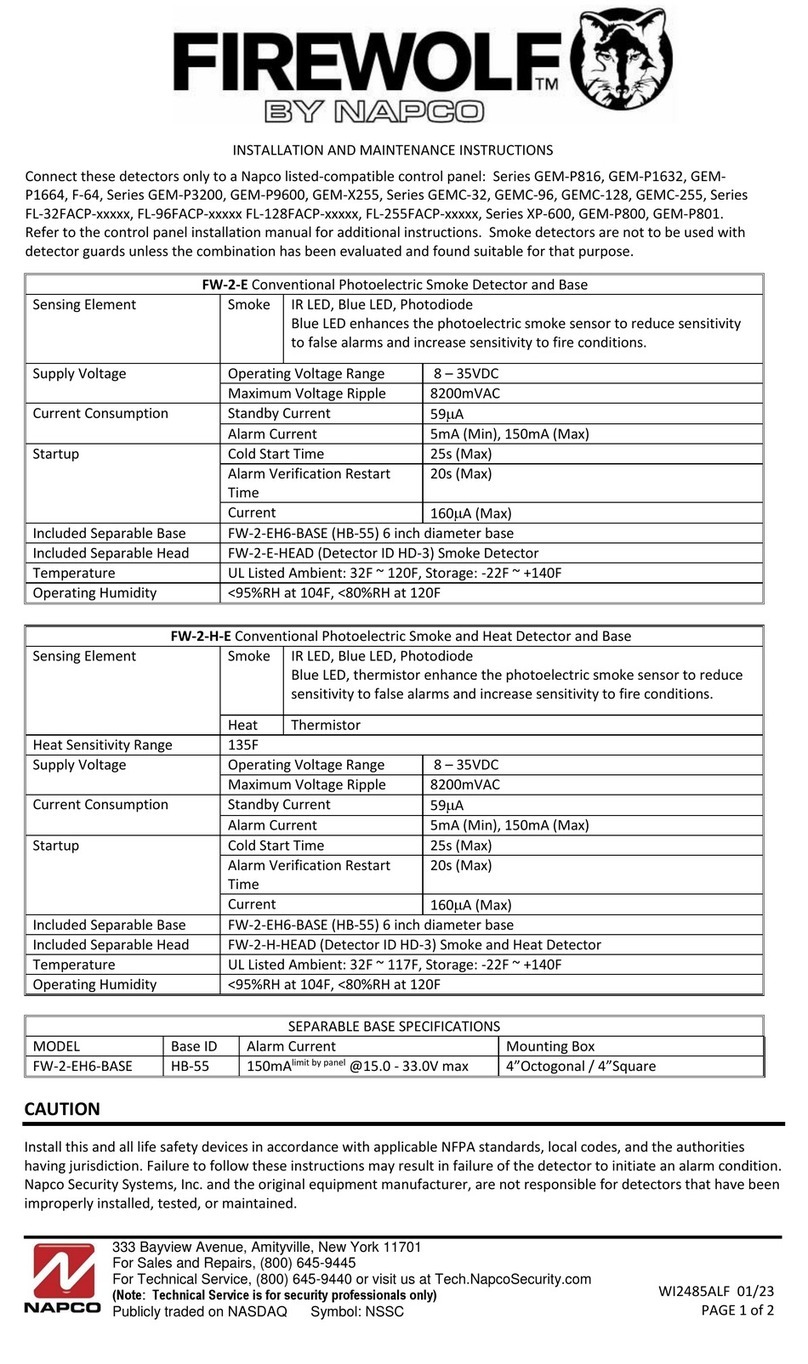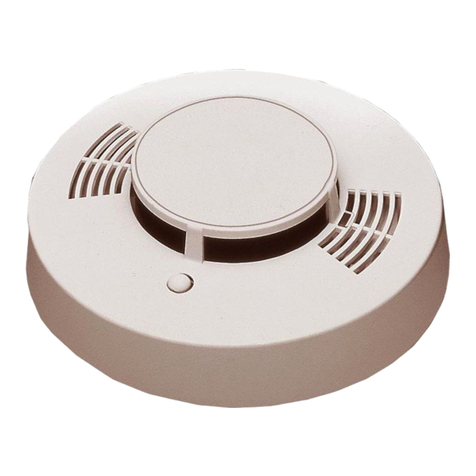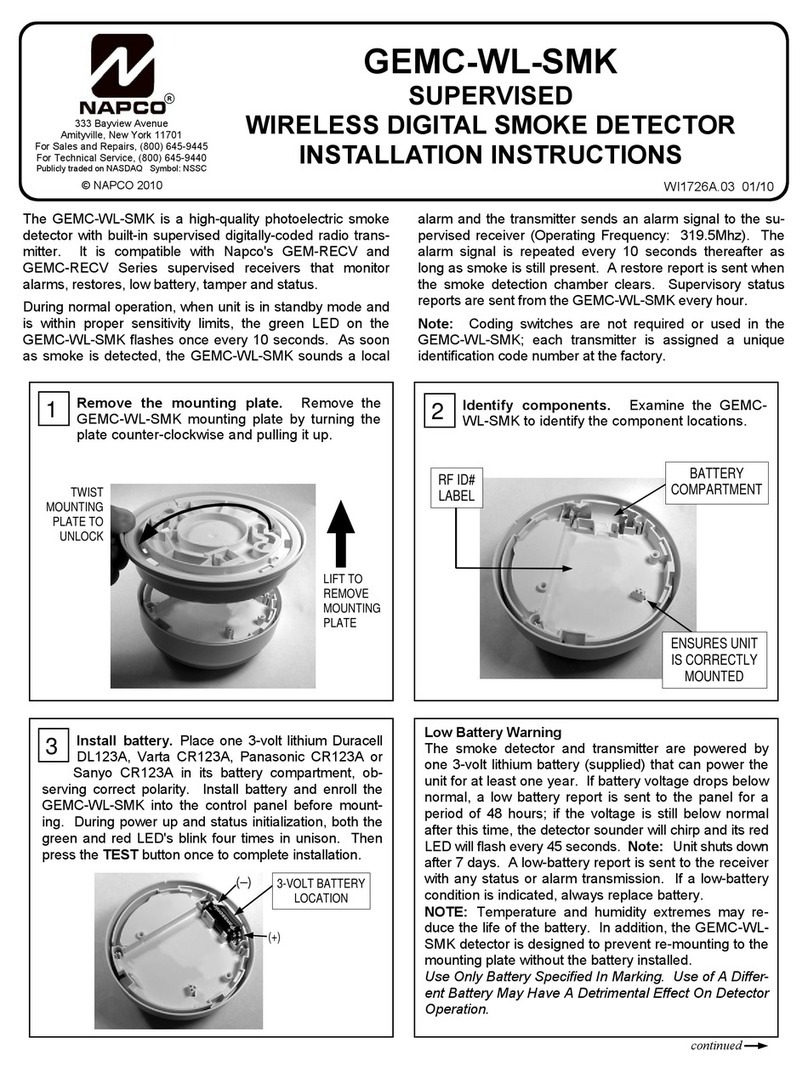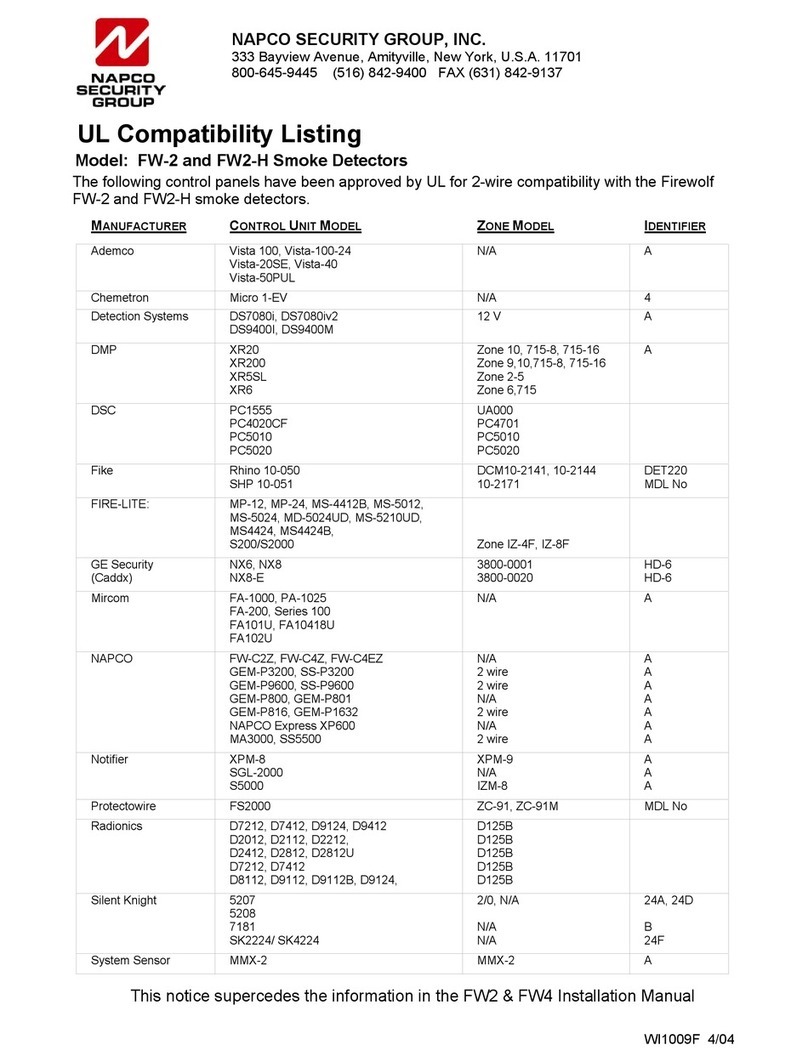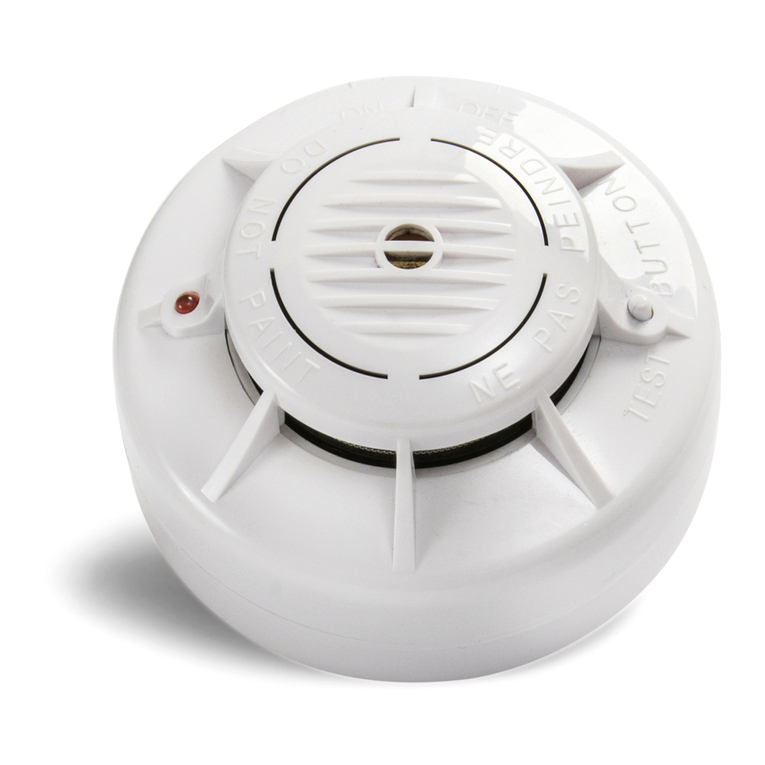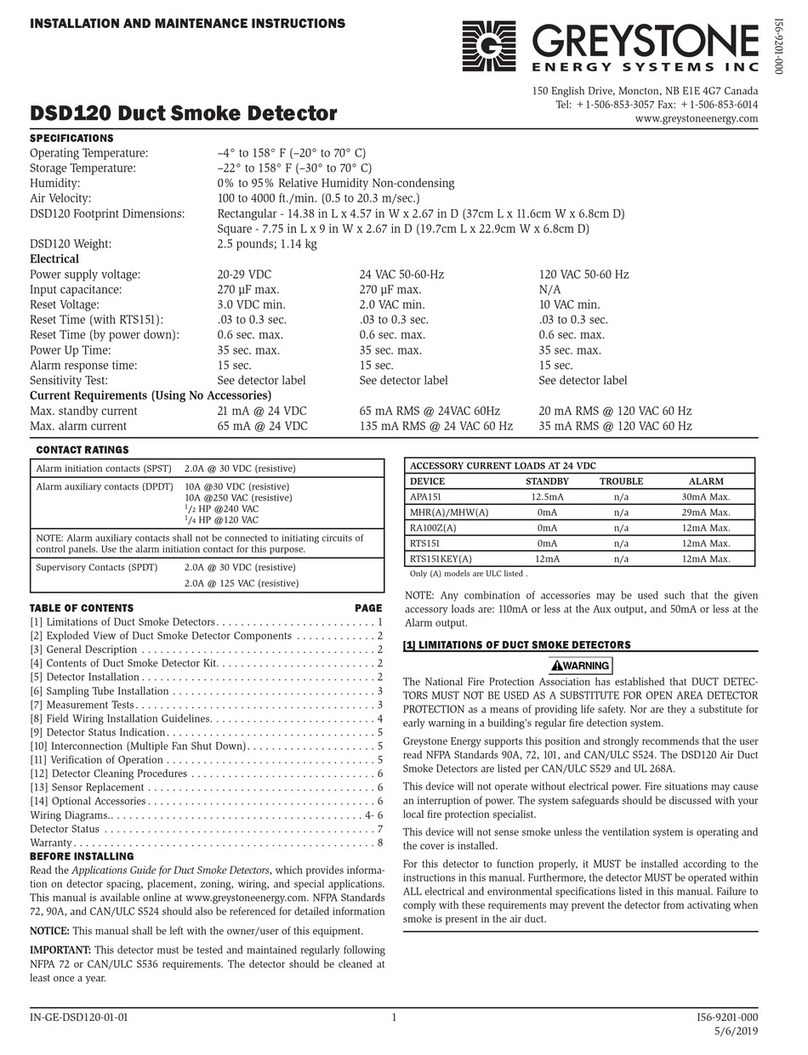
TESTING THE UNIT (Test Weekly)
1. All central station services, releasing devices and ex-
tinguisher systems must be disengaged during the test
period and must be re-engaged immediately after test-
ing.
2. After energizing the detector head for approximately
one minute, check to see the indicator two red LED's
flashing once every 7-10 seconds. If red LED fails to
flash, it indicates a non-functioning detector or faulty
wiring. Re-check the wiring or replace the detector if
necessary.
3. Position the "Test Magnet" against the side of the de-
tector housing marked "TEST" for at least 5 seconds.
The detector should trigger an alarm (as indicated by a
rapidly flashing red LED light and siren sounding). Re-
set the control unit to return to normal operation.
4. Allow smoke from a cotton wick or punk to enter the
detector-sensing chamber for at least 5 seconds.
When sufficient smoke has entered the chamber, an
alarm signal will be triggered (as indicated with a con-
tinuous red LED light). After alarm is triggered, reset
each detector and/or control unit before attempting to
test additional detectors in the same zone. If the alarm
fails to trigger an alarm, it indicates a defective unit.
CLEANING THE UNIT
MAINTENANCE WARNING
The smoke detector will warn that it must be cleaned when
the unit flashes the red LED every 5 seconds and the unit
does not pass the weekly test by the user (see TESTING
THE UNIT at left). To clean the smoke detector, vacuum the
outside of the unit at least once a year (preferably every six
months) using a soft brush attachment. Do not attempt to
clean the unit in any other way. If this maintenance proce-
dure fails to clean the unit sufficiently, call for service and/or
replace the unit.
COMPATIBLE CONTROL PANELS
GEM-X255, GEM-P3200, GEM-P9600, GEM-P800, GEM-
P801, GEM-P816, GEM-P1632, GEM-P1664, Freedom F-
64, NAPCO Express XP-600. Note: For cross listings with
additional manufacturers and models pending, contact the
NAPCO Technical Support department for the latest listings
at (800) 645-9440.
Also available online at www.napcosecurity.com (click the
following to download file "FW2_WI1009F.05_ADDM.pdf"):
●Support
●Manuals for Napco's Firewolf fire products
NAPCO LIMITED WARRANTY
NAPCO SECURITY SYSTEMS, INC. (NAPCO) warrants its products to
be free from manufacturing defects in materials and workmanship for thirty-
six months following the date of manufacture. NAPCO will, within said
period, at its option, repair or replace any product failing to operate
correctly without charge to the original purchaser or user.
This warranty shall not apply to any equipment, or any part thereof, which
has been repaired by others, improperly installed, improperly used,
abused, altered, damaged, subjected to acts of God, or on which any serial
numbers have been altered, defaced or removed. Seller will not be
responsible for any dismantling or reinstallation charges.
THERE ARE NO WARRANTIES, EXPRESS OR IMPLIED, WHICH
EXTEND BEYOND THE DESCRIPTION ON THE FACE HEREOF.
THERE IS NO EXPRESS OR IMPLIED WARRANTY OF
MERCHANTABILITY OR A WARRANTY OF FITNESS FOR A
PARTICULAR PURPOSE. ADDITIONALLY, THIS WARRANTY IS IN
LIEU OF ALL OTHER OBLIGATIONS OR LIABILITIES ON THE PART
OF NAPCO.
Any action for breach of warranty, including but not limited to any implied
warranty of merchantability, must be brought within the six months
following the end of the warranty period.
IN NO CASE SHALL NAPCO BE LIABLE TO ANYONE FOR ANY
CONSEQUENTIAL OR INCIDENTAL DAMAGES FOR BREACH OF
THIS OR ANY OTHER WARRANTY, EXPRESS OR IMPLIED, EVEN IF
THE LOSS OR DAMAGE IS CAUSED BY THE SELLER'S OWN
NEGLIGENCE OR FAULT.
In case of defect, contact the security professional who installed and
maintains your security system. In order to exercise the warranty, the
product must be returned by the security professional, shipping costs
prepaid and insured to NAPCO. After repair or replacement, NAPCO
assumes the cost of returning products under warranty. NAPCO shall have
no obligation under this warranty, or otherwise, if the product has been
repaired by others, improperly installed, improperly used, abused, altered,
damaged, subjected to accident, nuisance, flood, fire or acts of God, or on
which any serial numbers have been altered, defaced or removed.
NAPCO will not be responsible for any dismantling, reassembly or
reinstallation charges.
This warranty contains the entire warranty. It is the sole warranty and any
prior agreements or representations, whether oral or written, are either
merged herein or are expressly cancelled. NAPCO neither assumes, nor
authorizes any other person purporting to act on its behalf to modify, to
change, or to assume for it, any other warranty or liability concerning its
products.
In no event shall NAPCO be liable for an amount in excess of NAPCO's
original selling price of the product, for any loss or damage, whether direct,
indirect, incidental, consequential, or otherwise arising out of any failure of
the product. Seller's warranty, as hereinabove set forth, shall not be
enlarged, diminished or affected by and no obligation or liability shall arise
or grow out of Seller's rendering of technical advice or service in
connection with Buyer's order of the goods furnished hereunder.
NAPCO RECOMMENDS THAT THE ENTIRE SYSTEM BE
COMPLETELY TESTED WEEKLY.
Warning: Despite frequent testing, and due to, but not limited to, any or all
of the following; criminal tampering, electrical or communications
disruption, it is possible for the system to fail to perform as expected.
NAPCO does not represent that the product/system may not be
compromised or circumvented; or that the product or system will prevent
any personal injury or property loss by burglary, robbery, fire or otherwise;
nor that the product or system will in all cases provide adequate warning or
protection. A properly installed and maintained alarm may only reduce risk
of burglary, robbery, fire or otherwise but it is not insurance or a guarantee
that these events will not occur. CONSEQUENTLY, SELLER SHALL
HAVE NO LIABILITY FOR ANY PERSONAL INJURY, PROPERTY
DAMAGE, OR OTHER LOSS BASED ON A CLAIM THE PRODUCT
FAILED TO GIVE WARNING. Therefore, the installer should in turn advise
the consumer to take any and all precautions for his or her safety including,
but not limited to, fleeing the premises and calling police or fire department,
in order to mitigate the possibilities of harm and/or damage.
NAPCO is not an insurer of either the property or safety of the user's family
or employees, and limits its liability for any loss or damage including
incidental or consequential damages to NAPCO's original selling price of
the product regardless of the cause of such loss or damage.
Some states do not allow limitations on how long an implied warranty lasts
or do not allow the exclusion or limitation of incidental or consequential
damages, or differentiate in their treatment of limitations of liability for
ordinary or gross negligence, so the above limitations or exclusions may
not apply to you. This Warranty gives you specific legal rights and you may
also have other rights which vary from state to state.




